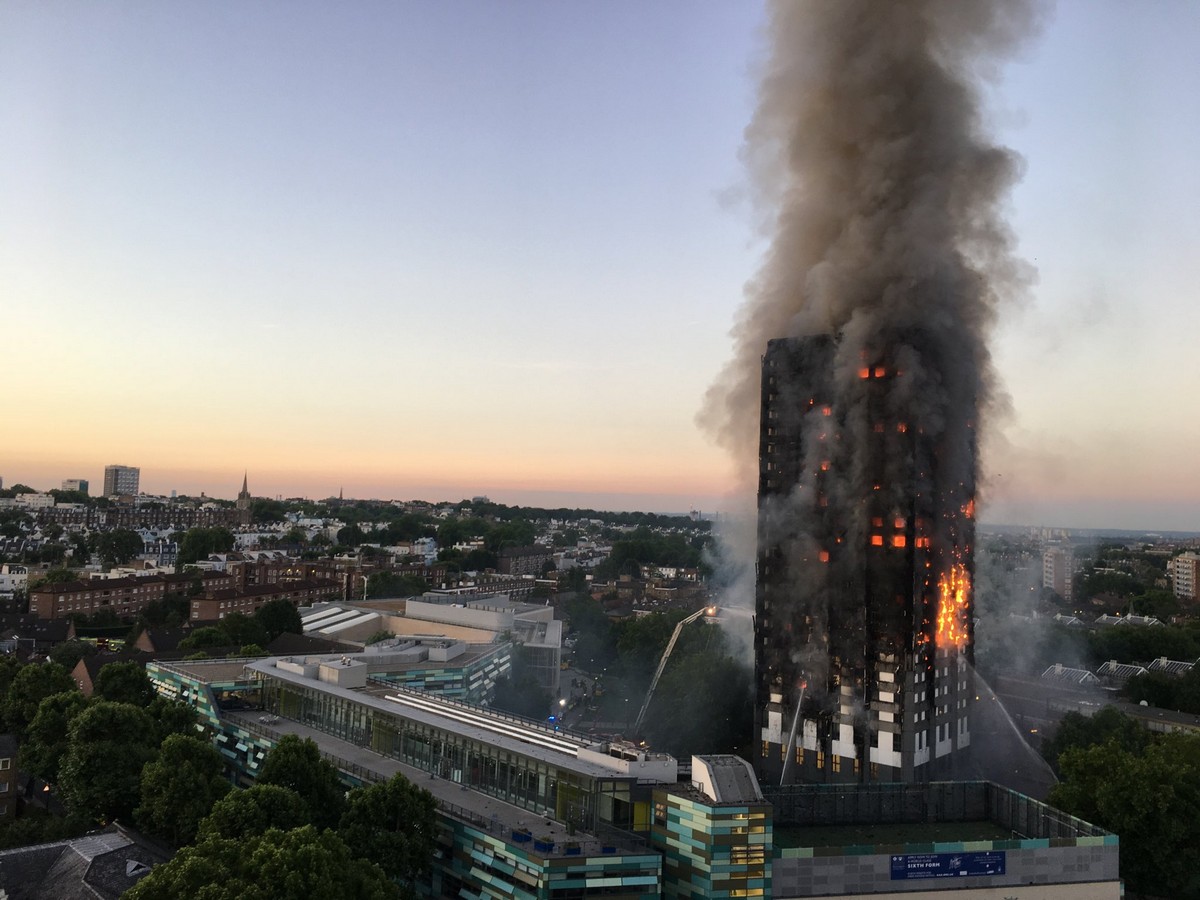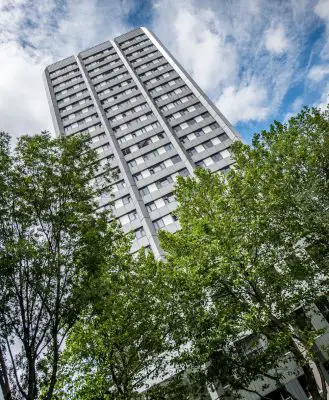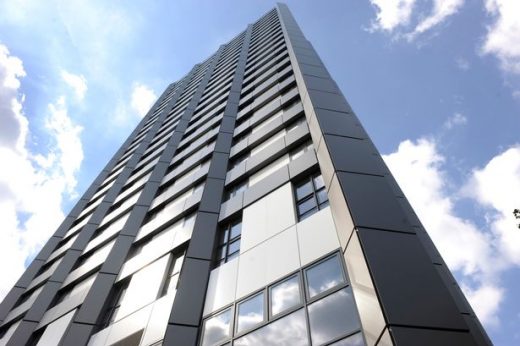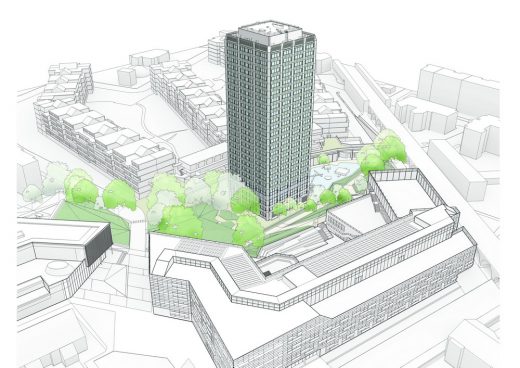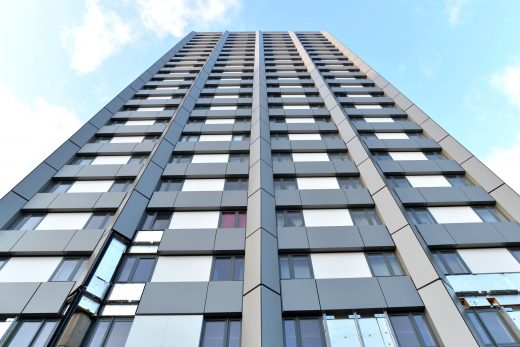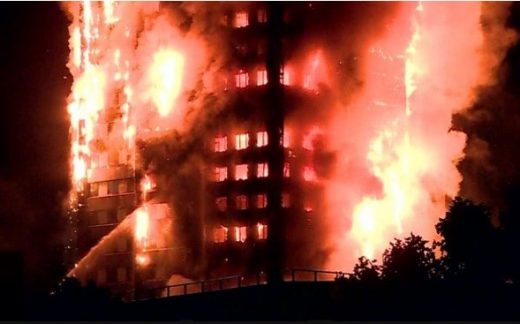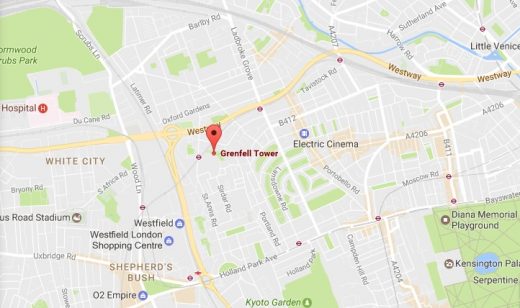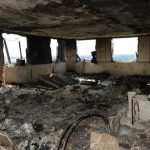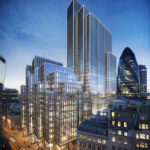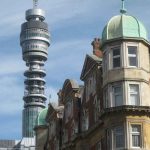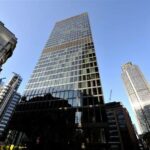Grenfell Tower fifth anniversary, West London Building Fire Brigades Union news, Inquiry Report
Grenfell Tower fifth anniversary news
14 June 2022
Grenfell fifth anniversary: firefighter numbers cut since Grenfell
The Fire Brigades Union has revealed that 221 firefighter positions have been cut since Grenfell, as the fifth anniversary of the fire takes place on 14 June.
The figure comes after large cuts to the fire and rescue service in the run-up to Grenfell, with for example the UK losing over 11,000 firefighter roles between 2010 and 2017, which is nearly one in five, and represent a failure to change course after years of deep cuts prior to Grenfell.
Grenfell Tower fire, 4:43 a.m. on 14 June 2017:
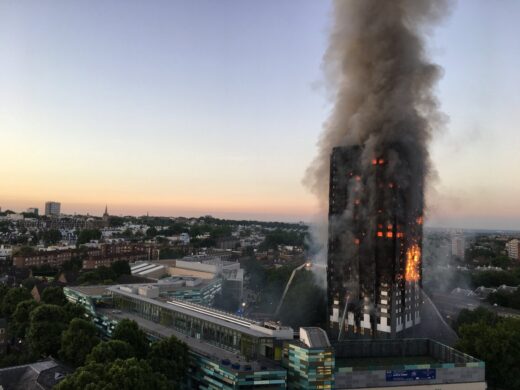
cropped photo by Natalie Oxford – https://twitter.com/Natalie_Oxford/status/874835244989513729/photo/1, CC BY 4.0, https://commons.wikimedia.org/w/index.php?curid=59913134, courtesy of wikimedia commons
Grenfell Tower Fifth Anniversary Comment
Matt Wrack, Fire Brigades Union general secretary, said:
“Despite the worst UK domestic fire in living memory the government is still failing to change direction, and take fire safety and the fire service seriously. It is an insult to the people who lost their lives and it is an insult to the Grenfell community.
“Unfortunately none of this is a surprise. Central government let Grenfell be turned into a fire trap and has done nothing to fix the building safety crisis that has come to light since. But nonetheless, we should not take our eye off just how heartless you have to be to see an incident like Grenfell and then continue on a path like this. They are gambling with lives.”
Please note that here firefighter roles includes fire control staff.
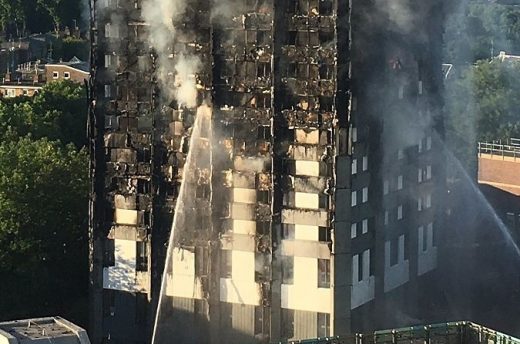
cropped photo by Natalie Oxford, courtesy of wikimedia commons
UK Firefighter numbers
A comparison of official figures, collated from Home Office and respective home nation sources, shows that there is less firefighters, defined to include fire control staff, now than at the time of Grenfell.
At the headcount performed closest to Grenfell itself – on 31 March 2017 – there was a total of 48,338 fulltime, on-call and fire control staff. On that same date four years later (2021), the most recent update, that total had dipped to 48,117.
Excludes Isle of Scilly. These figures are taken from Home Office and respective home nation sources, and relate to counts on 31 March of each year. Firefighters are defined to include fire control staff.
Grenfell Tower fifth anniversary comment provided by the The Fire Brigades Union (FBU).
14 June 2022
June 14, 2022
SMART: Movement in Solidarity with Grenfell Survivors to Delegate Global HQ of Capital Group in Los Angeles
Groups are calling for investment firm to divest from Kingspan, global insulation manufacturer and core participant in the ongoing U.K. government Grenfell Inquiry.
LOS ANGELES, CALIF. — A delegation of clergy and community allies of manufacturing workers at Kingspan will visit Capital Group’s headquarters today to demand the firm divest from Kingspan. Delegations will also happen at Capital Group offices in London and 14 cities in North America.
Capital Group became Kingspan’s largest outside shareholder after Kingspan testified in the Inquiry, and now holds over 15 million shares worth $1.5 billion. Philip May, the husband of former Prime Minister Theresa May, has worked as a Director of Retirement Income for Capital Group since 2005. Capital Group has ignored previous requests to meet with Kingspan workers and allies in the United States who are participating in today’s memorial and delegations.
“Today, we as Kingspan workers stand united in solidarity with all those in London marching for justice for the 72 people who lost their lives in the horrific Grenfell Tower fire on this day five years ago,” says Micaias Pacheco, a welder at Kingspan. “Here in Santa Ana, we continue to ask Kingspan to listen to our health and safety concerns for our own well-being, our families, and our community.”
SMART issued a report on Kingspan and the Grenfell Inquiry in March 2022. Pictures from today’s events will also be available.
After Kingspan managers testified in the ongoing U.K. government Grenfell Inquiry in 2020-2021, at least two institutional investors divested Kingspan stock completely, including Guinness and WHEB. Baillie Gifford sold over 3.5 million shares, Impax sold over 1.2 million, and AXA over 500,000 shares. Capital Group did the opposite, buying up 10 percent of Kingspan shares since the testimony revealed years of shortcomings in Kingspan’s approach to fire safety.
13 June 2022
Grenfell inquiry: New “massively significant” report released
The Fire Brigades Union has termed a new report to the Grenfell Tower Inquiry, released to the public today, “massively significant” evidence.
Grenfell Tower Report by Professor Luke Bisby
The report (visible at https://www.grenfelltowerinquiry.org.uk/evidence/professor-luke-bisby), written by Professor Luke Bisby, a professor of fire and structures at Edinburgh University and an expert witness to the inquiry, details the flaws with the Building Research Establishment (BRE), the government’s former safety research and testing body that was privatised in 1997. It was responsible for testing many of the cladding, insulation and other building materials used in the Grenfell refurbishment.
The report details previous cladding fires which can be viewed as missed opportunities to prevent Grenfell, and BRE failures around them. It also builds up a picture of BRE only doing work within contracts, and only specific things – close to client and government demands – within those contracts.
Bisby concludes that “what emerges from this overview of the development of England’s building regulatory environment, and the major cladding fires that have occurred during the same period, is a picture of increasing freedom for industry…”. He also highlights a “profound lack of competence of actors” including the BRE [both page 253] and “powerful commercial and ideological objectives” to increase flexibility for industry.
The union believes that many of these flaws can be explained by the privatisation of BRE and the creeping, increasing influence of the private sector in the BRE in the years running up to the completion of full privatisation.
Grenfell Tower smoke plume:
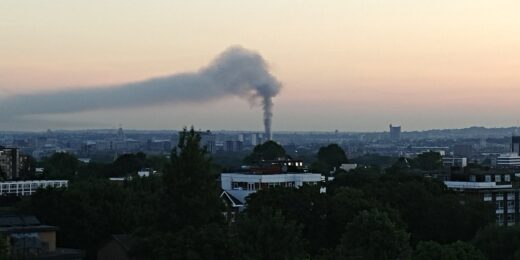
cropped photo by Cbakerbrian – Own work, CC BY-SA 4.0, https://commons.wikimedia.org/w/index.php?curid=106571476, courtesy of wikimedia commons
Mark Rowe, Fire Brigades Union national officer, said:
“Professor Bisby’s report details multiple failings on the BRE’s part in the run-up to Grenfell, failings which were caused – fundamentally – by private ownership and the increasing encroachment of the private sector. It is massively significant.
“We are clear: the BRE was not, and is not, fit for purpose, because it is privately-owned. It is vital that the BRE is taken back into public ownership and run for the public good, not profit.
“In the run-up to Grenfell their status as a private company meant that they were dependent on fee income from clients, such as Grenfell manufacturers. This made them too willing to please clients and too reluctant to challenge them or the information they provided. The BRE’s private status also meant it did not share information as it should have done, and there were basic failures of competence in vital areas.”
The Fire Brigades Union represents firefighters and control staff, including many of those who were involved in the response to Grenfell. It is a core participant to the inquiry.
More Detail:
The report is centred around Building Research Establishment failures, mainly in relation to key cladding fires:
- Around the Knowsley Heights fire in 1991 the BRE “had a significant organisational incentive to enable overcladding solutions whilst being seen to mitigate their fire risks – rather than prohibit their use” (page 253), with the BRE having significant “reputational investment” here (p100), and the failure to “properly interrogate the key issues” here is “tragic” (p99).
According to Bisby the BRE report has a “striking absence of any explicit discussion regard the degree to which the GRP rainscreen product may have contributed fuel to the fire” (page 98). The GRP rainscreen product was later found to have contributed to the fire (also page 98).
Bisby includes a handwritten note detailing a Department of Environment press office request to BRE to “play down the issue of the fire” (p104).
- Following the Garnock Court fire in 1999 there were “surprising oversights” made by the BRE with regards to a lack of investigation of cladding and other materials, and possible implications for building regulation (p125). “It is not clear” why a later, more detailed set of reports was not properly communicated to government or Parliament by BRE (page 136).
Around this fire there was an insight into how BRE worked and prioritised work: “We are a private sector organisation; we are not part of government. Clearly, in days gone by, when we were part of DoE then this work was done and would have been done in the public interest without the need for formal contract. One regrets there are now commercial pressures that require clients to place formal contracts with us before we can undertake work.” (BRE comments to the select committee on Environment, Transport and Regional Affairs, page 131).
- A BRE report on the Lakanal House fire “contains very little insight” into the roles of combustible materials in and on the walls in the fire’s development. Bisby expresses surprise that there was a lack of comment around the external fire spread at Lakanal (from p186 – para 1046, 1049, 1052, 1055, 1058) and the questions this should have raised in relation to building regulations.
- The “BRE “External Fire Spread” Reports (2014-2016) are in places incomprehensible, and they appear to lack in any real insights or practical significance” (page 229).
- As early as 2017 the BRE – as well as government – was aware of regulatory confusion that would later help lead to combustible material being used in the Grenfell refurbishment, but “it appears that little or no action was taken” by the BRE “to seek to highlight or mitigate this confusion or the resulting significant hazards” (page 255).
At FBU conference in May the FBU voted for a motion calling for the BRE to be nationalised.
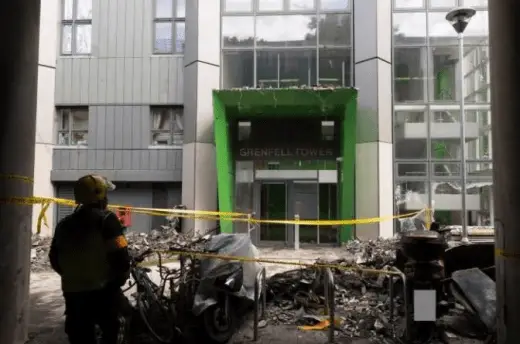
photograph : Metropolitan Police
7 June 2022
Firefighters union slams government rejection of key Grenfell inquiry recommendation for disabled people
The Fire Brigades Union has written to the government to demand it rethinks its decision to reject a key Grenfell Tower Inquiry recommendation, on the evacuation of disabled residents of high-rise buildings.
The inquiry recommended that “that the owner and manager of every high-rise residential building be required by law to prepare personal emergency evacuation plans (PEEPs)” for all disabled residents.
But last month the government rejected the recommendation and revealed downgraded plans, which have been roundly criticised including by Grenfell campaigners and disability rights campaigners.
The government had promised to implement the Grenfell Tower Inquiry phase one recommendations “in full”, of which this is one.
In a letter to Lord Greenhalgh dated 6 June 2022, Minister of State for Building Safety, Fire and Communities, Matt Wrack, Fire Brigades Union general secretary wrote [abridged]:
“The FBU was disappointed with the Westminster government’s decision to downgrade work towards ensuring residents with disabilities are provided with Personal Emergency Evacuation Plans (PEEPs)
“The [government] statement claims that implementation would involve significant issues with practicality, proportionality and safety. The FBU argues that resident safety is paramount, so there is a greater safety issue in declining to implement PEEPs. As for proportionality, the Inquiry has found the introduction of PEEPs to be a proportionate strategy, and the FBU agrees.
“Some reasons given for the refusal seem poorly evidenced, for example stating that if a PEEP advised the purchase of an evacuation chair, there would be an “impact on the good relations between disabled residents and non-disabled residents if disproportionate costs were passed on to the latter. Building owners should carry the costs.”
“The government’s decision is a negative, backward step, and the FBU stands with disability campaigners, the Grenfell campaign groups and the LGA in asking you to reconsider.”
15 out of 37 disabled Grenfell Tower residents lost their lives in the fire.
The union represents the vast majority of the hundreds of firefighters and fire control staff who were involved in the Grenfell response.
The full letter is included below:
Letter sent by email
Lord S Greenhalgh – Minister of State for Building Safety, Fire and Communities at
Ministry of Housing, Communities and Local Government and Home Office
6 June 2022
Dear Lord Greenhalgh,
The FBU was disappointed with the Westminster government’s decision published on 18 May 2022 to downgrade work towards ensuring residents with disabilities are provided with Personal Emergency Evacuation Plans (PEEPs).
Recommendation 12 (33.12.E) in the phase 1 report of the Grenfell Tower Inquiry demanded “that the owner and manager of every high-rise residential building be required by law to prepare personal emergency evacuation plans (PEEPs) for all residents whose ability to self-evacuate may be compromised (such as persons with reduced mobility or cognition)”. Recommendation 12 (33.12.F) stated that these PEEPs should be kept updated in a premises information box.
A consultation ran until July 2021 on the implementation of a PEEPs requirement, and the FBU contributed. The submission backed the views of disability rights campaigners and the implications of the Equalities Act for public bodies with duties to tackle discrimination. It stated: “The FBU strongly supports the introduction of mandatory personal emergency evacuation plans for all residents who need them… The FBU believes that the “responsible person” – the owners and managers of these high-rise residential buildings – should be the bodies called to account to provide personal emergency evacuation plans and bear the costs of doing so… The FBU believes an urgent task and finish group should be convened, composed of key organisations (including trade union representatives) to ensure there is a standard for the components of a PEEP, the best standards for those components and the assistance that responsible persons should provide.” The overwhelming majority of respondents were also in favour of the provision of PEEPs.
However, after some considerable delay the Westminster government now responds with a refusal to carry out this recommendation. The statement claims that implementation would involve significant issues with practicality, proportionality and safety. The FBU would argue that resident safety is paramount, so there is a greater safety issue in declining to implement PEEPs. As for proportionality, the Inquiry has found the introduction of PEEPs to be a proportionate strategy, and the FBU agrees. Fundamentally, the phase 1 report outlines the need for alternative evacuation plans because the ‘Stay Put’ condition can fail in the event of a total building failure, as occurred with Grenfell Tower. Some reasons given for the refusal seem poorly evidenced, for example stating that if a PEEP advised the purchase of an evacuation chair, there would be an “impact on the good relations between disabled residents and non-disabled residents if disproportionate costs were passed on to the latter”. Building owners should carry the costs.
The FBU consultation concluded that: “At the time of the Grenfell Tower fire, there were no authoritative policies and procedures for mass evacuation and rescue from fire. Four years on, there is still no definitive guidance on the evacuation and rescue process. Any future policies should be safe for residents and firefighters, with no more shortcuts or compromises.” Sadly this government’s decision is a negative, backward step, and the FBU stands with disability campaigners, the Grenfell campaign groups and the LGA in asking you to reconsider.
Kind regards.
Matt Wrack
General Secretary
Previously on e-architect:
Grenfell Tower
Grenfell Tower in West London – main page on this major British building fire
Grenfell Tower Fire Inquiry Part Two
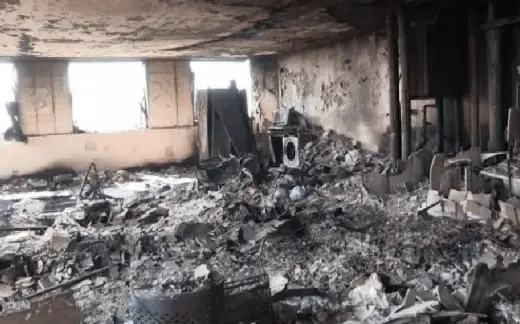
photograph : Metropolitan Police
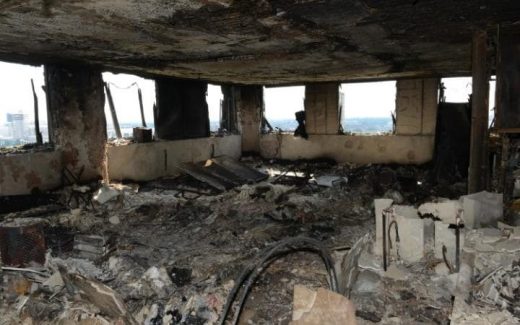
photograph : Metropolitan Police
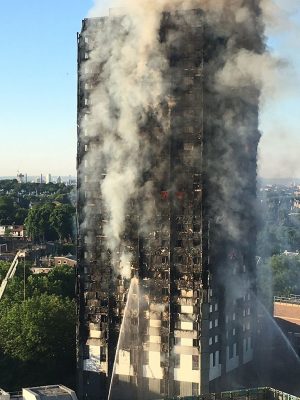
photo by Natalie Oxford, courtesy of wikimedia commons
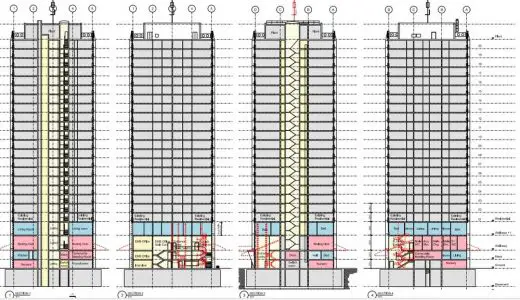
image courtesy of architects via planning portal
Tall Buildings in London
London Skyscraper Buildings – alphabetical list
Lakanal House tower block fire
Location: Lancaster West estate, North Kensington, London, England, UK
London Architecture
London Architecture Designs – chronological list
London Architecture Walking Tours
Comments / photos for the Grenfell Tower fifth anniversary: firefighter numbers page welcome

